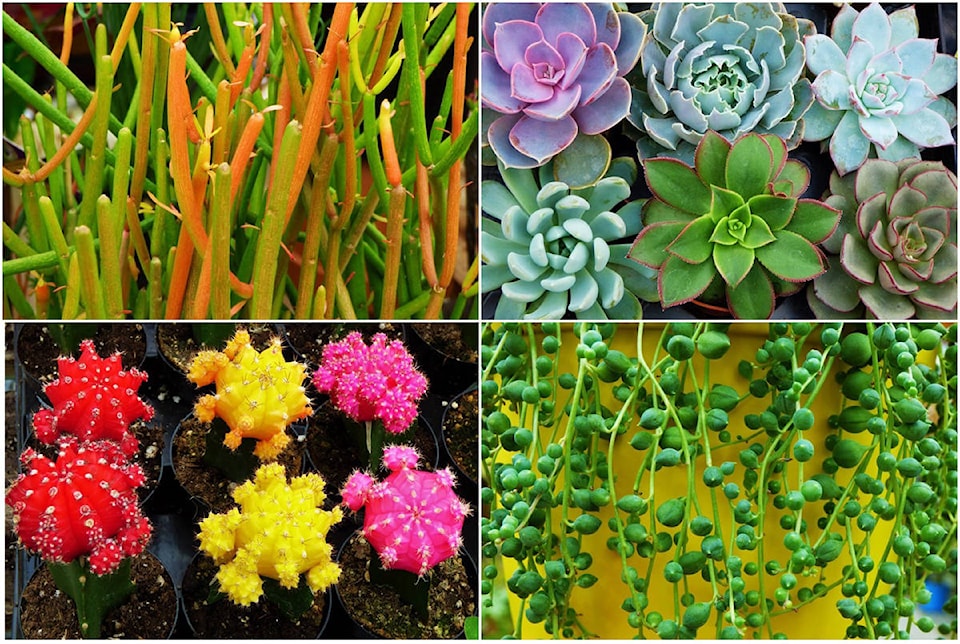It may seem strange that both financial constraints and the local real estate market conspire to create a plant trend, but that’s just what happened with the current interest in cacti and succulents.
These desert-like plants have been flying out the door of late, mostly in the hands of Millennials and those of the Generation Z ilk, young people dealing with skyrocketing cost of living, insane real estate prices and rents, as well as fewer career opportunities and heavy student loan debts – the result of which means that they live in small spaces or suites where the option for outdoor gardens do not exist and room for larger indoor houseplants is rather marginalized.
So being what they are, adapters, they have created their own garden trend of tiny succulent bowls, or collections of miniature cacti, which only require a brightly lit room or a window ledge to thrive.
The other advantage of this particular plant group is the never-ending variation of form and colour.
Whether it’s the vibrant grafts of Moon cactus (Gymnocalycium mihanovichii), the perfectly strung beads of String-of-Pearls (Senecio rowleyanus) or the glowing stems of Firesticks (Euphorbia tirucalli), there is something to suit every taste.
I think the best place to start is with a few general care rules and when it comes to succulents light is critical. Brighter coloured plants generally have higher sunlight needs. But if you can’t meet these lighting requirements, then try ZZ plant (Zamioculcas zamiifolia), Haworthia, Panda plant (Kalanchoe tomentosa) and Jade (Crassula ovata), all of which tolerate slightly shadier conditions.
Watering succulents is of equal importance and, rather than providing a little bit of water on a regular basis, you are much better off to water them until it runs out the drainage holes and then wait until the soil dries out completely before watering again.
The timing will change with the seasons, with more watering being required in spring, when they are in growth, and much less in winter, when light levels drop and the plants are somewhat dormant.
The other important point here is to apply the water to just the soil surface in order to avoid getting the foliage wet, as it can often pool in the leaf rosettes (like Echeveria) causing fungal rot.
When repotting, it is important to choose a container with drain holes, as well as a well-drained cactus soil blend.
Succulents also appreciate a topdressing of fine gravel or ornamental rock, not only for aesthetic appeal, but because it also helps to keep the foliage dry when it comes in contact with the soil surface.
Fertilize when the plants are in growth, using a water-soluble balanced fertilizer such as 10-10-10, diluted to quarter strength.
The range of available succulents is truly staggering, so here are some brief descriptions of what you can expect at your local garden centre:
• Living Stones (Lithops) – tiny succulents that resemble pebbles which are bisected and bear starry blooms from the central crack;
• Echeveria – a wide range of species with a rosette growth habit and jewel tone foliage of powder blue, purple, chocolate brown and many bicolors;
• Moon Cactus (Gymnocalycium) – these grafted mutants lack chlorophyll but make up for it with eye-dazzling red, purple, golden yellow and hot pink varieties;
• Firesticks (E. tirucalli) – a dense upright cluster of green finger-like foliage, often with fiery red to orange highlights;
• String-of-Pearls (S. rowleyanus) G– reen bead-like leaves strung on a living necklace which looks best as a hanging basket specimen;
• Donkey Tail (Sedum morganianum) – another trailing novelty with rope-like strands of fleshy greenish-grey foliage.
Mike Lascelle is a local nursery manager and gardening author (hebe_acer@hotmail.com).
